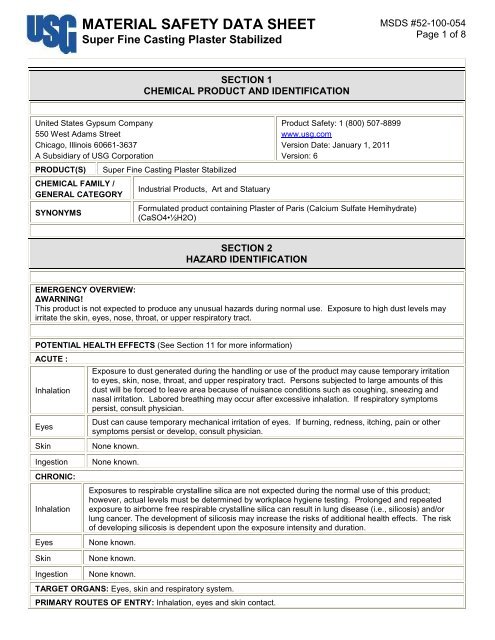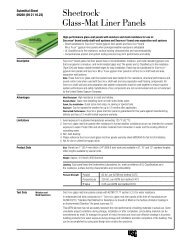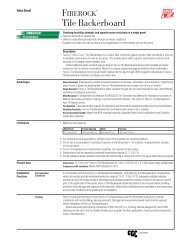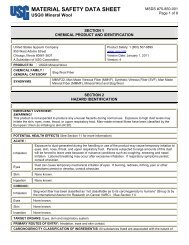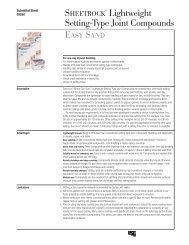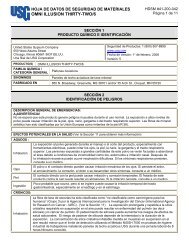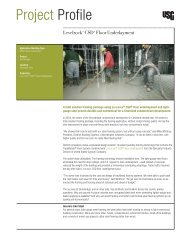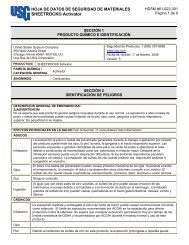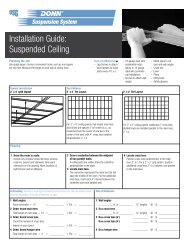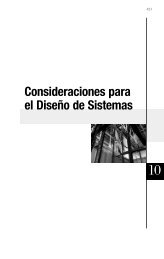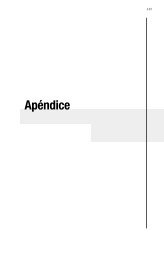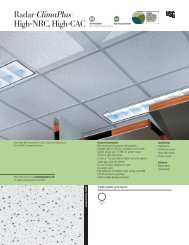MATERIAL SAFETY DATA SHEET - USG Corporation
MATERIAL SAFETY DATA SHEET - USG Corporation
MATERIAL SAFETY DATA SHEET - USG Corporation
Create successful ePaper yourself
Turn your PDF publications into a flip-book with our unique Google optimized e-Paper software.
52100054<br />
<strong>MATERIAL</strong> <strong>SAFETY</strong> <strong>DATA</strong> <strong>SHEET</strong><br />
Super Fine Casting Plaster Stabilized<br />
United States Gypsum Company<br />
550 West Adams Street<br />
Chicago, Illinois 60661-3637<br />
A Subsidiary of <strong>USG</strong> <strong>Corporation</strong><br />
PRODUCT(S) Super Fine Casting Plaster Stabilized<br />
CHEMICAL FAMILY /<br />
GENERAL CATEGORY<br />
SYNONYMS<br />
SECTION 1<br />
CHEMICAL PRODUCT AND IDENTIFICATION<br />
Industrial Products, Art and Statuary<br />
Product Safety: 1 (800) 507-8899<br />
www.usg.com<br />
Version Date: January 1, 2011<br />
Version: 6<br />
Formulated product containing Plaster of Paris (Calcium Sulfate Hemihydrate)<br />
(CaSO4•½H2O)<br />
SECTION 2<br />
HAZARD IDENTIFICATION<br />
MSDS #52-100-054<br />
Page 1 of 8<br />
EMERGENCY OVERVIEW:<br />
ΔWARNING!<br />
This product is not expected to produce any unusual hazards during normal use. Exposure to high dust levels may<br />
irritate the skin, eyes, nose, throat, or upper respiratory tract.<br />
POTENTIAL HEALTH EFFECTS (See Section 11 for more information)<br />
ACUTE :<br />
Inhalation<br />
Eyes<br />
Skin None known.<br />
Ingestion None known.<br />
CHRONIC:<br />
Inhalation<br />
Eyes None known.<br />
Skin None known.<br />
Ingestion None known.<br />
Exposure to dust generated during the handling or use of the product may cause temporary irritation<br />
to eyes, skin, nose, throat, and upper respiratory tract. Persons subjected to large amounts of this<br />
dust will be forced to leave area because of nuisance conditions such as coughing, sneezing and<br />
nasal irritation. Labored breathing may occur after excessive inhalation. If respiratory symptoms<br />
persist, consult physician.<br />
Dust can cause temporary mechanical irritation of eyes. If burning, redness, itching, pain or other<br />
symptoms persist or develop, consult physician.<br />
Exposures to respirable crystalline silica are not expected during the normal use of this product;<br />
however, actual levels must be determined by workplace hygiene testing. Prolonged and repeated<br />
exposure to airborne free respirable crystalline silica can result in lung disease (i.e., silicosis) and/or<br />
lung cancer. The development of silicosis may increase the risks of additional health effects. The risk<br />
of developing silicosis is dependent upon the exposure intensity and duration.<br />
TARGET ORGANS: Eyes, skin and respiratory system.<br />
PRIMARY ROUTES OF ENTRY: Inhalation, eyes and skin contact.
<strong>MATERIAL</strong> <strong>SAFETY</strong> <strong>DATA</strong> <strong>SHEET</strong><br />
Super Fine Casting Plaster Stabilized<br />
MSDS #52-100-054<br />
Page 2 of 8<br />
CARCINOGENICITY CLASSIFICATION OF INGREDIENT(S) All substances listed are associated with the nature of<br />
the raw materials used in the manufacture of this product and are not independent components of the product<br />
formulation. All substances, if present, are at levels well below regulatory limits. See Section 11: Toxicology<br />
Information for detailed information.<br />
<strong>MATERIAL</strong> IARC NTP ACGIH CAL- 65<br />
Crystalline silica 1 1 A2 Listed<br />
IARC - International Agency for Research on Cancer: 1- Carcinogenic to humans; 2A – Probably carcinogenic to<br />
humans; 2B – Possibly carcinogenic to humans; 3 - Not classifiable as a carcinogen; 4 – Probably not a carcinogen<br />
NTP – National Toxicology Program (Health and Human Services Dept., Public Health Service, NIH/NIEHS): 1-<br />
Known to be carcinogen; 2- Anticipated to be carcinogens<br />
ACGIH – American Conference of Governmental Industrial Hygienists: A1 – Confirmed human carcinogen; A2 –<br />
Suspected human carcinogen; A3 – Animal carcinogen; A4 - Not classifiable as a carcinogen; A5 – Not suspected as<br />
a human carcinogen<br />
CAL-65 – California Proposition 65 “Chemicals known to the State of California to Cause Cancer”<br />
Respirable crystalline silica: IARC: Group 1 carcinogen, NTP: Known human carcinogen. The weight percent of<br />
crystalline silica given represents total quartz and not the respirable fraction. The weight percent of respirable silica<br />
has not been measured in this product.<br />
POTENTIAL ENVIRONMENTAL EFFECTS: Toxicity studies performed with fish, aquatic invertebrates and aquatic<br />
plants showed no toxic effect. (See Section 12 for more information.)<br />
SECTION 3<br />
COMPOSITION, INFORMATION ON INGREDIENTS<br />
<strong>MATERIAL</strong> WT% CAS #<br />
Plaster of Paris (CaSO4•½H2O) >99<br />
Crystalline Silica
<strong>MATERIAL</strong> <strong>SAFETY</strong> <strong>DATA</strong> <strong>SHEET</strong><br />
Super Fine Casting Plaster Stabilized<br />
MSDS #52-100-054<br />
Page 3 of 8<br />
MEDICAL CONDITIONS WHICH MAY BE AGGRAVATED: Pre-existing upper respiratory and lung diseases such<br />
as, but not limited to, bronchitis, emphysema and asthma. Pre-existing skin diseases such as, but not limited to,<br />
rashes and dermatitis.<br />
NOTES TO PHYSICIAN: Treatment should be directed at the control of symptoms and the clinical condition.<br />
SECTION 5<br />
FIRE FIGHTING MEASURES<br />
General Fire Hazards Not expected to burn.<br />
Extinguishing Media Water or use extinguishing media appropriate for surrounding fire.<br />
Special Fire Fighting Procedures Wear appropriate personal protective equipment. See section 8.<br />
Unusual Fire/ Explosion Hazards None known<br />
Hazardous Combustion Products<br />
Above 1450º C - decomposes to calcium oxide (CaO) and sulfur dioxide<br />
(SO2).<br />
Flash Point Not Determined Auto Ignition Not Applicable<br />
Method Used Not Applicable Flammability<br />
Upper Flammable Limit (UFL) Not Determined Classification<br />
Not Applicable<br />
Lower Flammable Limit (LFL) Not Determined Rate of Burning Not Applicable<br />
SECTION 6<br />
ACCIDENTAL RELEASE MEASURES<br />
CONTAINMENT: No special precautions. Wear appropriate personal protective equipment. See section 8.<br />
CLEAN-UP: Use normal clean up procedures. No special precautions.<br />
DISPOSAL: Follow all local, state, provincial and federal regulations. Never discharge large releases directly into<br />
sewers or surface waters.<br />
SECTION 7<br />
HANDLING AND STORAGE<br />
HANDLING: Avoid dust contact with eyes and skin. Wear the appropriate eye and skin protection against dust (See<br />
Section 8). Minimize dust generation and accumulation. Avoid breathing dust. Wear the appropriate respiratory<br />
protection against dust in poorly ventilated areas and if TLV is exceeded (see Sections 2 and 8). Use good safety and<br />
industrial hygiene practices.<br />
STORAGE: Store in a cool, dry, ventilated area away from sources of heat, moisture and incompatibilities (see<br />
Section 10). As a dry powder, dew point conditions or other conditions causing presence of liquid will harden plaster<br />
of paris during storage.
<strong>MATERIAL</strong> <strong>SAFETY</strong> <strong>DATA</strong> <strong>SHEET</strong><br />
Super Fine Casting Plaster Stabilized<br />
SECTION 8<br />
EXPOSURE CONTROLS/PERSONAL PROTECTION<br />
MSDS #52-100-054<br />
Page 4 of 8<br />
<strong>MATERIAL</strong> WT% TLV (mg/m 3 ) PEL( mg/m 3 )<br />
Plaster of Paris (CaSO4•½H2O) >99<br />
Crystalline Silica
<strong>MATERIAL</strong> <strong>SAFETY</strong> <strong>DATA</strong> <strong>SHEET</strong><br />
Super Fine Casting Plaster Stabilized<br />
Upper Flammable Limit (UFL) Not Determined VOC Content Zero g/L<br />
Lower Flammable Limit (LFL) Not Determined Percent Volatile Zero<br />
Vapor Pressure (mm Hg) Not Applicable<br />
STABILITY Stable.<br />
SECTION 10<br />
CHEMICAL STABILITY AND REACTIVITY<br />
CONDITIONS TO AVOID Contact with acids, water, high humidity.<br />
INCOMPATIBILITY<br />
HAZARDOUS POLYMERIZATION None known.<br />
MSDS #52-100-054<br />
Page 5 of 8<br />
Acids. Exposure to water and acids must be supervised because the<br />
reactions are vigorous and produce large amounts of heat.<br />
HAZARDOUS DECOMPOSITION Above 1450º C - calcium oxide (CaO) and sulfur dioxide (SO2).<br />
SECTION 11<br />
TOXICOLOGICAL INFORMATION<br />
ACUTE EFFECTS: The acute oral toxicity study [OECD TG 420] of calcium sulfate dihydrate showed that this<br />
chemical did not cause any changes even at 2,000 mg/kg b.w. Therefore, the oral LD50 value was more than 2,000mg/kg<br />
b.w. for female rats. Gypsum paste applied experimentally to the eyes of rabbits was not an irritant. Gypsum<br />
dust particulate has shown an irritant action on mucous membranes of the respiratory tract and eyes. The sulfate ion<br />
has caused gastro-intestinal disturbance in humans following large oral doses. Limited studies involving the repeated<br />
inhalation of an (unspecified) calcium sulfate failed to identify any particular target organs in monkeys, rats and<br />
hamsters. No evidence of mutagenicity was found in Ames bacterial tests.<br />
CHRONIC EFFECTS / CARCINOGENICITY:<br />
Plaster of Paris: Testing of dust from <strong>USG</strong> plaster of paris has not detected respirable crystalline silica.<br />
Crystalline Silica: Exposures to respirable crystalline silica are not expected during the normal use of this product;<br />
however, actual levels must be determined by workplace hygiene testing. The weight percent of respirable crystalline<br />
silica may not have been measured in this product. Prolonged and repeated exposure to airborne free respirable<br />
crystalline silica can result in lung disease (i.e., silicosis) and/or lung cancer. The development of silicosis may<br />
increase the risks of additional health effects. Smoking in combination with silica exposures increases the risk of<br />
cancer. The risk of developing silicosis is dependent upon the exposure intensity and duration.<br />
In June, 1997, IARC classified crystalline silica (quartz and cristobalite) as a human carcinogen. In making the overall<br />
evaluation, the IARC Working Group noted that carcinogenicity in humans was not detected in all industrial<br />
circumstances studied. Carcinogenicity may be dependent on inherent characteristics of the crystalline silica or on<br />
external factors affecting its biological activity or distribution of its polymorphs.<br />
IARC states that crystalline silica inhaled in the form of quartz or cristobalite from occupational sources is carcinogenic<br />
to humans (Group 1).<br />
SECTION 12<br />
ECOLOGICAL INFORMATION
<strong>MATERIAL</strong> <strong>SAFETY</strong> <strong>DATA</strong> <strong>SHEET</strong><br />
Super Fine Casting Plaster Stabilized<br />
MSDS #52-100-054<br />
Page 6 of 8<br />
ENVIRONMENTAL TOXICITY: This product has no known adverse effect on ecology. Toxicity studies performed<br />
with fish, aquatic invertebrates and aquatic plants showed no toxic effect.<br />
Ecotoxicity value Not determined.<br />
SECTION 13<br />
DISPOSAL CONSIDERATIONS<br />
WASTE DISPOSAL METHOD: Dispose of material in accordance with federal, state, and local regulations. Never<br />
discharge directly into sewers or surface waters. Consult with environmental regulatory agencies for guidance on<br />
acceptable disposal practices. Slurry may plug drains. Trace amounts of residue can be flushed to a drain, using<br />
plenty of water.<br />
SECTION 14<br />
TRANSPORT INFORMATION<br />
U.S. DOT INFORMATION: Not a hazardous material per DOT shipping requirements. Not classified or regulated.<br />
Shipping Name Same as product name.<br />
Hazard Class Not classified.<br />
UN/NA # None. Not classified.<br />
Packing Group None.<br />
Label (s) Required Not applicable.<br />
GGVSec/MDG-Code Not classified.<br />
ICAO/IATA-DGR Not applicable.<br />
RID/ADR None.<br />
ADNR None.<br />
UNITED STATES REGULATIONS<br />
SECTION 15<br />
REGULATORY INFORMATION<br />
All ingredients of this product are included in the U.S. Environmental Protection Agency’s Toxic Substances Control<br />
Act Chemical Substance Inventory.<br />
<strong>MATERIAL</strong> WT%<br />
Plaster of Paris (CaSO4•½H2O) >99<br />
Crystalline Silica
<strong>MATERIAL</strong> <strong>SAFETY</strong> <strong>DATA</strong> <strong>SHEET</strong><br />
Super Fine Casting Plaster Stabilized<br />
SARA Title III Section 304 (EPCRA) Extremely Hazardous Substances: Reportable Quantity (RQ)<br />
SARA Title III Section 313 (EPCRA) Toxic Chemicals: X= Subject to reporting under section 313<br />
CERCLA Hazardous Substances: Reportable Quantity (RQ)<br />
MSDS #52-100-054<br />
Page 7 of 8<br />
CAA Section 112 (r) Regulated Chemicals for Accidental Release Prevention: Threshold Quantities(TQ)<br />
RCRA Hazardous Waste: RCRA hazardous waste code<br />
CANADIAN REGULATIONS<br />
This product has been classified in accordance with the hazard criteria of Controlled Product regulations and the<br />
MSDS contains all the information required by the Controlled Products Regulations. All ingredients of this product are<br />
included in the Canadian Domestic Substances List (DSL).<br />
<strong>MATERIAL</strong> WT% IDL Item #<br />
Plaster of Paris (CaSO4•½H2O) >99<br />
Crystalline Silica
<strong>MATERIAL</strong> <strong>SAFETY</strong> <strong>DATA</strong> <strong>SHEET</strong><br />
Super Fine Casting Plaster Stabilized<br />
ANSI American National Standards Institute<br />
ACGIH American Conference of Governmental Industrial Hygienists<br />
CAA Clean Air Act<br />
CAS Chemical Abstracts Service (Registry Number)<br />
CERCLA Comprehensive Environmental Response, Compensation and Liability Act of 1980<br />
CFR Code of Federal Regulations<br />
DOT United States Department of Transportation<br />
DSL Canadian Domestic Substances List<br />
EPA United States Environmental Protection Agency<br />
EPCRA Emergency Planning & Community Right-to-know Act<br />
HMIS Hazardous Materials Identification System<br />
IARC International Agency for Research on Cancer<br />
MSHA Mine Safety and Health Administration<br />
NDSL Canadian Non-Domestic Substances List<br />
NFPA National Fire Protection Association<br />
NIOSH National Institute for Occupational Safety and Health<br />
OSHA Occupational Health and Safety Administration<br />
PEL Permissible Exposure Limit<br />
PPE Personal Protection Equipment<br />
RCRA Resource Conservation and Recovery Act<br />
SARA Superfund Amendments and Reauthorization Act of 1986<br />
TLV Threshold Limit Value<br />
TSCA Toxic Substances Control Act<br />
UN/NA# United Nations/North America number<br />
WHMIS Workplace Hazardous Material Information System<br />
Prepared by:<br />
Product Safety<br />
<strong>USG</strong> <strong>Corporation</strong><br />
550 West Adams Street<br />
Chicago, IL 60661-3637<br />
MSDS #52-100-054<br />
Page 8 of 8<br />
The information contained in this document applies to this specific material as supplied. It may not be valid for this<br />
material if it is used in combination with any other materials. It is the user’s responsibility to satisfy oneself as to the<br />
suitability and completeness of this information for his/her own particular use.<br />
END


